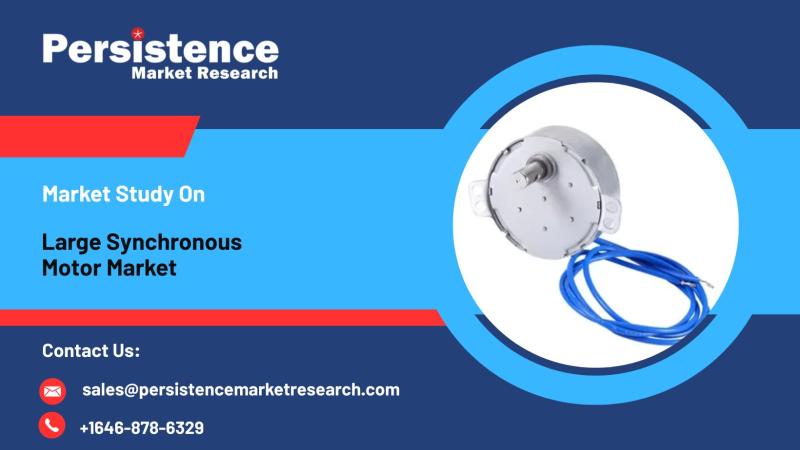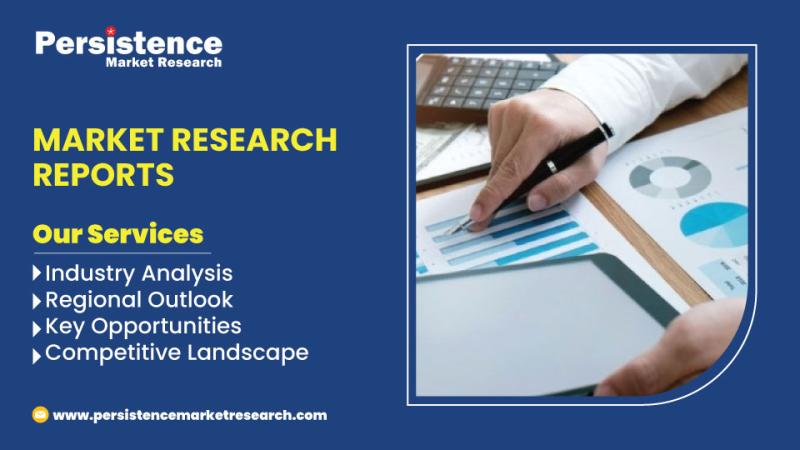Press release
Reverse Osmosis Pump Market Expected to Reach US$15.9 Billion by 2032, Reveals Persistence Market Research Report
The global reverse osmosis (RO) pump market is witnessing substantial growth as the demand for efficient water purification systems continues to escalate across industries, municipalities, and households. Valued at approximately US$8.6 billion in 2025, the market is projected to reach US$15.9 billion by 2032, expanding at a CAGR of 8.5% during the forecast period. This strong upward trajectory reflects the increasing global focus on water conservation, desalination, and sustainable water treatment technologies. The growing awareness of clean water accessibility, coupled with rising environmental concerns over freshwater scarcity, has positioned reverse osmosis systems-especially their pumping units-at the forefront of modern water management solutions.Get a Sample PDF Brochure of the Report: https://www.persistencemarketresearch.com/samples/35715
Reverse osmosis pumps play a pivotal role in enhancing the energy efficiency and performance of RO systems by maintaining consistent pressure across membranes, thereby ensuring optimal filtration and water recovery rates. The industrial sector currently dominates market share due to the rising adoption of RO systems in manufacturing, power generation, and chemical processing facilities where high-purity water is a critical operational requirement. Meanwhile, the Asia-Pacific region leads the global market, driven by massive infrastructure investments in water desalination and wastewater treatment projects across China, India, and Southeast Asia. Rapid urbanization, industrial expansion, and government-led initiatives promoting clean water accessibility are fueling the region's dominance in the global reverse osmosis pump landscape.
Key Highlights from the Report
• The global reverse osmosis pump market is projected to reach US$15.9 billion by 2032, growing at a CAGR of 8.5% between 2025 and 2032.
• Rising water scarcity and increasing desalination projects are major growth accelerators for the RO pump industry.
• The industrial segment remains the largest end-user due to stringent requirements for ultrapure water in manufacturing processes.
• Asia-Pacific dominates global demand, supported by government initiatives to expand water treatment infrastructure.
• Technological innovations in energy recovery devices and high-efficiency pump designs are reshaping market dynamics.
• Strategic collaborations and sustainable product development are strengthening competitive positioning among key players.
Market Segmentation
The reverse osmosis pump market can be segmented based on pump type, application, and end-user industry, each reflecting distinct growth patterns and demand dynamics.
By pump type, the market includes high-pressure pumps, booster pumps, and circulation pumps. High-pressure pumps represent the largest segment, as they are critical for maintaining the necessary pressure difference to drive water through semi-permeable membranes in RO systems. These pumps are extensively used in industrial and municipal desalination plants. Booster pumps, on the other hand, are gaining momentum in residential and commercial installations, ensuring optimal flow rates and system efficiency in smaller-scale RO units.
By application, the market spans desalination plants, wastewater treatment, process water generation, and domestic water purification. Desalination accounts for the highest market share, reflecting the growing number of coastal nations investing in seawater conversion projects to combat freshwater scarcity. The process water segment also shows robust growth, particularly across the food and beverage, pharmaceuticals, and power generation industries, where consistent water purity levels are essential for product quality and process reliability.
By end-user, industries such as municipal utilities, industrial manufacturing, commercial facilities, and residential consumers drive demand. The industrial sector leads the market due to the increasing installation of large-scale RO systems in refineries, chemical plants, and semiconductor facilities. Meanwhile, the residential segment is expected to record the fastest growth rate, fueled by rising health awareness and adoption of point-of-use water purification systems in emerging markets.
Read More In Detail: https://www.persistencemarketresearch.com/market-research/reverse-osmosis-pump-market.asp
Regional Insights
The Asia-Pacific region remains the global leader in the reverse osmosis pump market, accounting for the largest revenue share in 2025 and continuing its dominance through 2032. Countries such as China, India, Japan, and South Korea are making significant investments in large-scale desalination plants, municipal water infrastructure, and industrial wastewater recycling facilities. Government policies focused on sustainable water management and industrial efficiency have catalyzed the adoption of reverse osmosis technologies across multiple end-user sectors.
North America represents another key regional market, with the United States leading in technological innovation and the adoption of advanced RO systems for both municipal and industrial water treatment applications. Growing concerns regarding water contamination, along with the modernization of aging water infrastructure, are driving demand for high-performance RO pumps across the region.
In Europe, the market growth is propelled by stringent environmental regulations, particularly those related to industrial wastewater discharge and sustainability goals. Countries like Germany, the UK, and France are emphasizing eco-efficient technologies that reduce energy consumption and carbon emissions, spurring the integration of energy recovery systems with RO pumps.
The Middle East and Africa (MEA) region is also emerging as a vital growth hub due to massive investments in desalination projects across Saudi Arabia, the UAE, and Israel-countries heavily reliant on desalinated water for domestic and industrial consumption. Meanwhile, Latin America, led by Brazil and Mexico, is witnessing increased adoption of reverse osmosis systems in the food processing and mining sectors, where consistent water quality is critical.
Market Drivers
The primary driver of the reverse osmosis pump market is the rising global water scarcity, which has intensified efforts toward desalination and advanced water purification technologies. Rapid industrialization, urban expansion, and population growth have significantly increased water consumption levels, straining existing freshwater resources. Governments and private players are investing heavily in sustainable water infrastructure projects that employ RO systems for both seawater and brackish water treatment.
Another key driver is the technological advancement in pump design and materials. Modern RO pumps are being developed with higher energy efficiency, corrosion resistance, and enhanced durability, allowing them to handle harsh operational environments. Integration of smart sensors and digital monitoring systems is also enabling predictive maintenance and improved system reliability, reducing downtime and operational costs.
The rising adoption of renewable energy-powered desalination plants-particularly those using solar and wind energy-is creating additional momentum for energy-efficient pump systems. These innovations align with global sustainability goals, enabling RO pump manufacturers to cater to environmentally conscious markets. Furthermore, growing regulatory pressure for sustainable industrial practices and compliance with water quality standards are pushing industries to adopt advanced RO technologies at scale.
Market Restraints
Despite its promising growth, the reverse osmosis pump market faces several challenges. The most significant restraint is the high capital and maintenance cost associated with RO systems, especially for large-scale desalination and industrial plants. These systems require substantial energy input to maintain high operating pressures, resulting in elevated operational expenses that can deter small- and medium-scale enterprises from adopting the technology.
Additionally, membrane fouling and scaling issues often reduce system efficiency, increasing the frequency of maintenance and component replacement, including pumps. The limited availability of skilled professionals to manage and maintain complex RO systems in certain regions also hampers efficient operation and adoption.
Another key challenge lies in the environmental impact of brine disposal, a byproduct of the desalination process. The concentrated saline discharge can harm marine ecosystems, prompting regulatory agencies to impose stricter environmental compliance requirements. Pump manufacturers must therefore design systems that minimize brine generation and energy consumption while maintaining high throughput efficiency.
Do You Have Any Query Or Specific Requirement? Request Customization of Report: https://www.persistencemarketresearch.com/request-customization/35715
Market Opportunities
The reverse osmosis pump market presents multiple avenues for future growth. One of the most promising opportunities lies in technological innovation and digital integration. The ongoing transition toward smart water management systems and IoT-enabled pump solutions allows real-time performance monitoring, predictive maintenance, and remote control, offering greater reliability and operational efficiency.
Another significant opportunity exists in emerging economies, where rapid urbanization and industrialization are creating large-scale demand for clean water infrastructure. Government programs in India, Southeast Asia, and Africa aimed at expanding access to potable water are likely to drive extensive adoption of reverse osmosis systems in the coming decade.
The integration of energy recovery devices (ERDs) into pump systems also presents a critical growth avenue. These technologies can drastically reduce energy consumption, which accounts for a major portion of the operational costs in desalination plants. Manufacturers focusing on developing compact, cost-efficient, and high-performance RO pumps that incorporate ERDs are likely to gain a strong competitive edge in the market.
Company Insights
The global reverse osmosis pump market is moderately consolidated, with leading players focusing on product innovation, energy efficiency, and strategic collaborations to strengthen their market footprint. Key players operating in this space include:
• Grundfos Holding A/S
• Xylem Inc.
• Flowserve Corporation
• Pentair plc
• Ebara Corporation
• Sulzer Ltd.
• SPX FLOW, Inc.
• KSB SE & Co. KGaA
• Wanner Engineering, Inc.
• Danfoss A/S
Recent Developments:
In 2024, Grundfos introduced its latest energy-optimized RO pump line, integrating intelligent monitoring features and reduced lifecycle energy consumption by nearly 15%, marking a significant advancement in sustainable water treatment technology.
Xylem Inc. partnered with a Middle Eastern desalination plant in 2023 to deploy advanced reverse osmosis pumping systems integrated with digital twin technology for real-time operational optimization and reduced downtime.
Related Reports:
https://www.persistencemarketresearch.com/market-research/thermostatic-mixing-valves-market.asp
https://www.persistencemarketresearch.com/market-research/spot-welding-robots-market.asp
https://www.persistencemarketresearch.com/market-research/limit-switches-market.asp
https://www.persistencemarketresearch.com/market-research/mud-pressure-gauges-market.asp
https://www.persistencemarketresearch.com/market-research/hydraulic-casing-jacks-market.asp
Persistence Market Research
Second Floor, 150 Fleet Street, London, EC4A 2DQ, United Kingdom
USA Phone: +1 646-878-6329
UK Phone: +44 203-837-5656
Email: sales@persistencemarketresearch.com
Web:
https://www.persistencemarketresearch.com
About Persistence Market Research:
At Persistence Market Research, we specialize in creating research studies that serve as strategic tools for driving business growth. Established as a proprietary firm in 2012, we have evolved into a registered company in England and Wales in 2023 under the name Persistence Research & Consultancy Services Ltd. With a solid foundation, we have completed over 3600 custom and syndicate market research projects, and delivered more than 2700 projects for other leading market research companies' clients.
Our approach combines traditional market research methods with modern tools to offer comprehensive research solutions. With a decade of experience, we pride ourselves on deriving actionable insights from data to help businesses stay ahead of the competition. Our client base spans multinational corporations, leading consulting firms, investment funds, and government departments. A significant portion of our sales comes from repeat clients, a testament to the value and trust we've built over the years.
This release was published on openPR.
Permanent link to this press release:
Copy
Please set a link in the press area of your homepage to this press release on openPR. openPR disclaims liability for any content contained in this release.
You can edit or delete your press release Reverse Osmosis Pump Market Expected to Reach US$15.9 Billion by 2032, Reveals Persistence Market Research Report here
News-ID: 4265474 • Views: …
More Releases from Persistence Market Research

Heat Pump Market Expected to Reach US$180.3 Billion by 2032, Reveals Persistence …
The global heat pump market is undergoing rapid transformation as industries and consumers increasingly shift toward energy-efficient and sustainable heating and cooling technologies. According to the latest report from Persistence Market Research, the global heat pump market size is estimated to be valued at US$87.4 billion in 2025 and is projected to reach US$180.3 billion by 2032, expanding at a strong CAGR of 10.9% during the forecast period (2025-2032). This…

Precast Concrete Market Projected to Attain US$210.9 Billion by 2032, Reveals Pe …
The global precast concrete market is entering a phase of transformative growth, driven by rapid urbanization, increasing infrastructure investments, and the global push toward sustainable and efficient construction practices. Valued at US$137.5 billion in 2025, the market is projected to reach US$210.9 billion by 2032, expanding at a CAGR of 6.3% between 2025 and 2032. Precast concrete - a high-strength construction material produced by casting concrete in reusable molds under…

Large Synchronous Motor Market Projected to Reach US$13.9 Billion by 2032, Revea …
The global large synchronous motor market is entering a period of robust expansion, propelled by the industrial sector's accelerating shift toward energy efficiency, automation, and smart manufacturing. Valued at US$9.0 billion in 2025, the market is forecasted to reach US$13.9 billion by 2032, growing at a CAGR of 5.5% during the period from 2025 to 2032. Large synchronous motors, known for their precision speed control and high power efficiency, play…

Telemedicine Market to Surge to US$372.5 Bn by 2032, Says Persistence Market Res …
The telemedicine market has emerged as a transformative segment within the global healthcare ecosystem, leveraging digital technologies to bridge geographical gaps and improve access to healthcare services. By utilizing information and communication technologies (ICT), telemedicine enables healthcare providers to deliver consultations, diagnostics, and patient monitoring remotely. This market is broadly categorized under eHealth (electronic health) and mHealth (mobile health), encompassing services delivered through internet-enabled devices and mobile platforms. These solutions…
More Releases for Reverse
Reverse Mortgage Expert Kevin Guttman Releases Book about the Benefits of Revers …
Reverse mortgages remain one of the most misunderstood financial tools for seniors, often surrounded by confusion and stigma. In his new book, A Reverse Mortgage Changed My Life!!! , Certified Reverse Mortgage Professional (CRMP) and Senior Mortgage Broker Kevin A. Guttman addresses these misconceptions directly. Drawing from real-life stories, Guttman explains how reverse mortgages work, clears up common myths, and highlights how they can provide financial stability and peace of…
Understanding Reverse VAT: Why You Need a Reverse VAT Calculator
If you've ever had to work backwards from a total amount to figure out how much VAT was included, you've already come across the concept of reverse VAT - whether you knew it or not. It's a handy method for calculating the net price and VAT amount when all you have is the final total. This process is essential for business owners, freelancers, and anyone trying to stay financially accurate.
The…
Reverse Factoring Market
The reverse factoring market has been experiencing significant growth, with its market size accounted for USD 530.8 billion in 2022. It is projected to achieve a remarkable market size of USD 1,452.1 billion by 2032, growing at a compound annual growth rate (CAGR) of 10.8% from 2023 to 2032. This substantial growth is driven by various market trends, emerging opportunities, and a competitive landscape that is continuously evolving.
Download Free Reverse…
Reverse Mortgage Providers Market Analysis by 2028, Industry Trends, Size, Share …
Reverse Mortgage Providers market Overview: The report focuses on providing corporate insights and advice to help clients make strategic business moves and to grow over a long time in their respective markets. The report on the Reverse Mortgage Providers market assists readers in obtaining useful information and in promoting their growth. The market report covers a thorough study conducted through an overall analysis of the industry. It provides an overview…
Reverse Mortgage Providers Market 2021 - American Advisors Group (AAG), Finance …
Reverse Mortgage Providers Market research report is very indispensable in many ways for business growth and to thrive in the market. Getting well-versed about the trends and opportunities in the industry is a fairly time-consuming process. Nonetheless, this global Reverse Mortgage Providers Market research report solves this problem very quickly and easily. Clients can unearth the best opportunities to be successful in the market with excellent practice models and methods…
Reverse Engineering Bespoke Parts
We use the data gathered during the inspection to replicate the design, create a 3D model from CAD drawings, and generate a functioning part that meets your performance expectations. When this process is complete, the customer has the exact instructions he needs to replicate the part exactly as it needs to be, saving a lot of time and money in retrospect. Reverse engineering enables the duplication of existing parts by…
